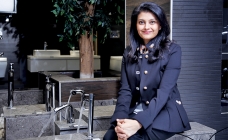‘Programmatic puts targeting precision at the core of campaigns’
By Rajiv Raghunath - January 17, 2022
Franck Vidal, Director, Southeast Asia Sales & Partnerships, Vistar Media shares his perspectives on how programmatic tech creates a win-win opportunity for marketers, buyers and media operators, in an interview to Rajiv Raghunath. Edited excerpts:
 From a time when programmatic was viewed as not quite workable for a medium like OOH/DOOH, over the last 2-3 years programmatic has become a key talking point in OOH industry discussions. In your view, what factors are contributing to a wider industry acceptance of programmatic OOH/DOOH?
From a time when programmatic was viewed as not quite workable for a medium like OOH/DOOH, over the last 2-3 years programmatic has become a key talking point in OOH industry discussions. In your view, what factors are contributing to a wider industry acceptance of programmatic OOH/DOOH?
Programmatic has opened new doors in the out-of-home industry for both buyers and signage operators. Once optional, the ability to respond quickly to shifting world events and conditions in real time is now deemed critical. As all behaviours have changed since the onset of the COVID-19 pandemic, marketers clamour for data to understand the ever-evolving consumer habits and movement patterns. Programmatic technology allows buyers to manage their OOH media spend in real-time through streamlined platforms for planning and campaign management. These systems can now provide for seamless campaign management, granular control, and the agility and flexibility to adjust strategy as conditions shift.
With buyers laser-focused on the efficiency of every bit of media spend, they need to deliver strategies that maximise impact with sophisticated targeting. Programmatic puts targeting precision at the core of campaigns. Marketers can layer on specific audience segments, time- and day-parting, weather triggers, and use POI targeting to surround or exclude key locations.
On the side of a campaign, buyers are increasingly held accountable for success and making the most of every dollar. Advancements in both data and technology have paved the way for robust OOH measurement products that can evaluate a campaign’s impact on brand lift, foot traffic, online conversion and even real-world purchases.
For digital signage operators, programmatic technology opens up the opportunity to increase their yield. Operators are no longer restricted to loop-based buys where they would have to dedicate a spot in their loop to a single buyer. By opening their supply to programmatic buys, OOH companies have become more aligned with digital practices. This also results in new business opportunities from advertisers and digital buyers who traditionally didn’t buy OOH but are now interested due to the benefits programmatic provides.
Do you see advertisers showing a greater appreciation of the benefits of using OOH/DOOH channels for advertising through programmatic platforms? What has been the experience of Vistar Media in this regard?
Absolutely. We’ve seen impressive adoption from local, regional and global advertisers across all verticals throughout the past few years. The unique benefits that programmatic has brought to the out-of-home industry has enabled the medium to better fit alongside the other core digital channels in a brand’s media mix. The uncertainty of the world has shined a light on the importance of programmatic in allowing for quicker activations, data-driven decisioning, and real-time shifts. While several of our clients started small with test budgets, we have seen the majority make room for digital out-of-home as a core fixture in their omni-channel media mix.
At Vistar, our mission is to grow the overall share of the out-of-home industry. We spend a lot of time educating advertisers about digital out-of-home and all of the capabilities that programmatic technology brings. We’ve been working closely with industry organisations to help develop better standards to important OOH themes, such as venue taxonomy and exposure methodology.
We’ve seen an interesting mix of brands that are increasing their investment in out-of-home. For example, CPG, one of the largest advertising spend categories, historically had under-spent in OOH; thanks to programmatic, these brands are now heavily investing in data-driven OOH strategies. On the other hand, some niche but highly digitally savvy industries such as crypto, e-commerce, electric vehicles, fintech and online gambling are seeing great results from programmatic DOOH.
Is the scale-up of DOOH networks central to the growth of pDOOH, and what factors will contribute to the scale-up of DOOH networks? And, how do you see these developments in the Asia context?
Digital adoption is fundamental to the expansion of programmatic DOOH, and we are seeing that happening across South East Asia. CAPEX implication has become more and more manageable for publishers and media owners due to screen costs getting lower. With the developments in local hardware and software, Vistar’s SSP can plug into any CMS, making it easy for networks to start earning programmatic revenue immediately.
Traditional OOH screens such as billboards bring visibility and impact for advertisers — but OOH is not just billboards. Place-based networks such as screens in gyms, malls, or airports are critical to the industry and help catch a wider variety of audiences, which is needed to fulfill the audience-based mission that programmatic DOOH brings.
Every country is transforming OOH placements into digital, but each country is moving at their own pace. While Thailand has rapidly converted thousands of billboards into digital signage, markets like Vietnam and the Philippines are experiencing digital transformation that is a bit slower but still happening.
Does it concern you that there is an increasing number of programmatic platforms coming up in different markets? Do you expect consolidation of business in this area?
We’ve seen an emergence of programmatic platforms in many different markets, and it is not a concern for us. Competition creates opportunity and will further stimulate demand if platforms deploy the right products in the interest of true programmatic out-of-home.
In DOOH-mature markets like North America and Australia/New Zealand, the increasing number of programmatic platforms has translated to promising demand for the medium. At Vistar, we believe that fair and smart competition helps us to further our mission of growing the overall adoption of out-of-home and enables us to surpass ourselves by bringing more advanced and relevant solutions to the market.
As with any industry, we expect that over time both advertisers and signage operators will identify preferred partners that meet their specific needs and provide value to the overall OOH ecosystem.
Would you reckon that pDOOH is helping to create a robust tech ecosystem for OOH as a whole?
Yes, the rise of digital screens and programmatic technology in out-of-home has created an extremely robust ecosystem! At Vistar, we don’t launch a product for the sake of launching it. We listen to our customers and take real feedback into account when developing our roadmap. We decide to invest in advancements once we have a solid product in line, based on our digital DNA and the needs of the market.
The rise of programmatic has required many signage networks to re-evaluate their underlying systems in order to better support a new line of revenue. This in turn spurs innovation and investment in cutting-edge software solutions. Based on our decade of experience integrating with hundreds of signage networks, Vistar realised that a new approach to ad serving and content management is required to fully realise the vision of programmatic. Built for the nuances of out-of-home, Vistar has developed a full suite of technology solutions — from a CMS (Cortex) to programmatic solutions (ad server, DSP and SSP) — to elevate the industry and help OOH become a true digital channel.

Stay on top of OOH media trends








